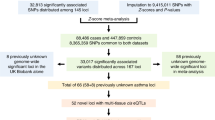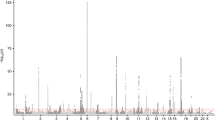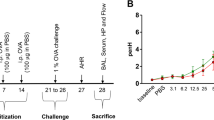Abstract
To simplify the analysis of asthma susceptibility genes located at human chromosome 5q23-35, we examined congenic mice that differed at the homologous chromosomal segment. We identified a Mendelian trait encoded by T cell and Airway Phenotype Regulator (Tapr). Tapr is genetically distinct from known cytokine genes and controls the development of airway hyperreactivity and T cell production of interleukin 4 (IL-4) and IL-13. Positional cloning identified a gene family that encodes T cell membrane proteins (TIMs); major sequence variants of this gene family (Tim) completely cosegregated with Tapr. The human homolog of TIM-1 is the hepatitis A virus (HAV) receptor, which may explain the inverse relationship between HAV infection and the development of atopy.
This is a preview of subscription content, access via your institution
Access options
Subscribe to this journal
Receive 12 print issues and online access
$209.00 per year
only $17.42 per issue
Buy this article
- Purchase on Springer Link
- Instant access to full article PDF
Prices may be subject to local taxes which are calculated during checkout






Similar content being viewed by others
References
Hjern, A., Haglund, B. & Hedlin, G. Ethnicity, childhood environment and atopic disorder. Clin. Exp. Allergy 30, 521–528 (2000).
Palmer, L. J. & Cookson, W. O. Genomic approaches to understanding asthma. Genome Res. 10, 1280–1287 (2000).
McNally, N. J., Phillips, D. R. & Williams, H. C. The problem of atopic eczema: aetiological clues from the environment and lifestyles. Soc. Sci. Med. 46, 729–741 (1998).
Woolcock, A. J. & Peat, J. K. Evidence for the increase in asthma worldwide. Ciba Found. Symp. 206, 122–134 (1997).
Asher, M. I. et al. International Study of Asthma and Allergies in Childhood (ISAAC): rationale and methods. Eur. Respir. J. 8, 483–491 (1995).
Weiss, K. B. & Sullivan, S. D. The health economics of asthma and rhinitis. I. Assessing the economic impact. J. Allergy Clin. Immunol. 107, 3–8 (2001).
Shirakawa, T., Enomoto, T., Shimazu, S. & Hopkin, J. M. The inverse association between tuberculin responses and atopic disorder. Science 275, 77–79 (1997).
Matricardi, P. M. et al. Cross sectional retrospective study of prevalence of atopy among Italian military students with antibodies against hepatitis A virus. Brit. J. Med. 314, 999–1003 (1997).
Marsh, D. G. et al. Linkage analysis of IL4 and other chromosome 5q31.1 markers and total serum immunoglobulin E concentrations. Science 264, 1152–1156 (1994).
Postma, D. S. et al. Genetic susceptibility to asthma—bronchial hyperresponsiveness coinherited with a major gene for atopy. N. Engl. J. Med. 333, 894–900 (1995).
A genome-wide search for asthma susceptibility loci in ethnically diverse populations. The Collaborative Study on the Genetics of Asthma (CSGA). Nature Genet. 15, 389–392 (1997).
Hershey, G. K., Friedrich, M. F., Esswein, L. A., Thomas, M. L. & Chatila, T. A. The association of atopy with a gain-of-function mutation in the α subunit of the interleukin-4 receptor. N. Engl. J. Med. 337, 1720–1725 (1997).
Ober, C. et al. Variation in the interleukin 4-receptor α gene confers susceptibility to asthma and atopy in ethnically diverse populations. Am. J. Hum. Genet. 66, 517–526 (2000).
Cookson, W. O. & Hopkin, J. M. Dominant inheritance of atopic immunoglobulin-E responsiveness. Lancet 1, 86–88 (1988).
Cookson, W. O., Sharp, P. A., Faux, J. A. & Hopkin, J. M. Linkage between immunoglobulin E responses underlying asthma and rhinitis and chromosome 11q. Lancet 1, 1292–1295 (1989).
Howard, T. D., Meyers, D. A. & Bleecker, E. R. Mapping susceptibility genes for asthma and allergy. J. Allergy Clin. Immunol. 105, 477–481 (2000).
Yokouchi, Y. et al. Significant evidence for linkage of mite-sensitive childhood asthma to chromosome 5q31-q33 near the interleukin 12 B locus by a genome-wide search in Japanese families. Genomics 66, 152–160 (2000).
Noguchi, E. et al. Evidence for linkage between asthma/atopy in childhood and chromosome 5q31-q33 in a Japanese population. Am. J. Respir. Crit. Care Med. 156, 1390–1393 (1997).
Loots, G. G. et al. Identification of a coordinate regulator of interleukins 4, 13, and 5 by cross-species sequence comparisons. Science 288, 136–140 (2000).
Walley, A. J., Wiltshire, S., Ellis, C. M. & Cookson, W. O. Linkage and allelic association of chromosome 5 cytokine cluster genetic markers with atopy and asthma associated traits. Genomics 72, 15–20 (2001).
Juniper, E. F., Frith, P. A., Dunnett, C., Cockcroft, D. W. & Hargreave, F. E. Reproducibility and comparison of responses to inhaled histamine and methacholine. Thorax 33, 705–710 (1978).
Hargreave, F. E. et al. Bronchial responsiveness to histamine or methacholine in asthma: measurement and clinical significance. J. Allergy Clin. Immunol. 68, 347–355 (1981).
Potter, M. et al. A BALB/c congenic strain of mice that carries a genetic locus (Ityr) controlling resistance to intracellular parasites. Infect. Immun. 40, 1234–1235 (1983).
Ruscetti, S., Matthai, R. & Potter, M. Susceptibility of BALB/c mice carrying various DBA/2 genes to development of Friend murine leukemia virus-induced erythroleukemia. J. Exp. Med. 162, 1579–1587 (1985).
Potter, M., Mushinski, E. B., Wax, J. S., Hartley, J. & Mock, B. A. Identification of two genes on chromosome 4 that determine resistance to plasmacytoma induction in mice. Cancer Res. 54, 969–975 (1994).
DeKruyff, R. H., Fang, Y. & Umetsu, D. T. IL-4 synthesis by in vivo primed keyhole limpet hemocyanin-specific CD4+ T cells. I. Influence of antigen concentration and antigen- presenting cell type. J. Immunol. 149, 3468–3476 (1992).
Hansen, G., Berry, G., DeKruyff, R. H. & Umetsu, D. T. Allergen-specific TH1 cells fail to counterbalance TH2 cell-induced airway hyperreactivity but cause severe airway inflammation. J. Clin. Invest. 103, 175–183 (1999).
Wills-Karp, M. Immunologic basis of antigen-induced airway hyperresponsiveness. Annu. Rev. Immunol. 17, 255–281 (1999).
Cohn, L., Homer, R. J., Marinov, A., Rankin, J. & Bottomly, K. Induction of airway mucus production By T helper 2 (TH2) cells: a critical role for interleukin 4 in cell recruitment but not mucus production. J. Exp. Med. 186, 1737–1747 (1997).
The Jackson Laboratory Mouse Genome Informatics (The Jackson Laboratory, Bar Harbor, ME, 2001).
Silver, L. M. Mouse Genetics: Concepts and applications (Oxford University Press, New York, 1995).
Brady, K. P. et al. Genetic mapping of 262 loci derived from expressed sequences in a murine interspecific cross using single-strand conformational polymorphism analysis. Genome. Res. 7, 1085–1093 (1997).
Ichimura, T. et al. Kidney injury molecule-1 (KIM-1), a putative epithelial cell adhesion molecule containing a novel immunoglobulin domain, is up-regulated in renal cells after injury. J. Biol. Chem. 273, 4135–4142 (1998).
Teuscher, C. et al. Sequence polymorphisms in the chemokines Scya1 (TCA-3), Scya2 (monocyte chemoattractant protein (MCP)-1), and Scya12 (MCP-5) are candidates for eae7, a locus controlling susceptibility to monophasic remitting/nonrelapsing experimental allergic encephalomyelitis. J. Immunol. 163, 2262–2266 (1999).
Guler, M. L. et al. Tpm1, a locus controlling IL-12 responsiveness, acts by a cell- autonomous mechanism. J. Immunol. 162, 1339–1347 (1999).
Van Etten, W. J. et al. Radiation hybrid map of the mouse genome. Nature Genet. 22, 384–387 (1999).
Lander, E. S. et al. Initial sequencing and analysis of the human genome. Nature 409, 860–921 (2001).
McPherson, J. D. et al. A physical map of the human genome. Nature 409, 934–941 (2001).
Lander, E. S. et al. Initial sequencing and analysis of the human genome. Nature 409, 860–921 (2001).
Fowell, D. J. et al. Impaired NFATc translocation and failure of TH2 development in Itk-deficient CD4+ T cells. Immunity 11, 399–409 (1999).
Ryu, S., Zhou, S., Ladurner, A. G. & Tjian, R. The transcriptional cofactor complex CRSP is required for activity of the enhancer-binding protein Sp1. Nature 397, 446–450 (1999).
Monney, L. et al. Identification and characterization of novel cell surface molecules expressed on TH1 cells. Scand. J. Immunol. 54, 35 (2001).
Feigelstock, D., Thompson, P., Mattoo, P., Zhang, Y. & Kaplan, G. G. The human homolog of HAVcr-1 codes for a hepatitis A virus cellular receptor. J. Virol. 72, 6621–6628 (1998).
Feigelstock, D., Thompson, P., Mattoo, P. & Kaplan, G. G. Polymorphisms of the hepatitis A virus cellular receptor 1 in African green monkey kidney cells result in antigenic variants that do not react with protective monoclonal antibody 190/4. J. Virol. 72, 6218–6222 (1998).
Hsieh, C. S., Heimberger, A. B., Gold, J. S., O'Garra, A. & Murphy, K. M. Differential regulation of T helper phenotype development by interleukins 4 and 10 in an αβ T-cell-receptor transgenic system. Proc. Natl Acad. Sci. USA 89, 6065–6069 (1992).
Kamogawa, Y., Minasi, L. A., Carding, S. R., Bottomly, K. & Flavell, R. A. The relationship of IL-4- and IFNγ-producing T cells studied by lineage ablation of IL-4-producing cells. Cell 75, 985–995 (1993).
Matricardi, P. M., Rosmini, F., Rapicetta, M., Gasbarrini, G. & Stroffolini, T. Atopy, hygiene, and anthroposophic lifestyle. San Marino Study Group. Lancet 354, 430 (1999).
Matricardi, P. M. et al. Exposure to foodborne and orofecal microbes versus airborne viruses in relation to atopy and allergic asthma: epidemiological study. Brit. J. Med. 320, 412–417 (2000).
Wu, C. et al. SAP controls T cell responses to virus and terminal differentiation of TH2 cells. Nature Immunol. 2, 410–414 (2001).
Tatsuo, H., Ono, N., Tanaka, K. & Yanagi, Y. SLAM (CDw150) is a cellular receptor for measles virus. Nature 406, 893–897 (2000).
Schneider-Schaulies, J. Cellular receptors for viruses: links to tropism and pathogenesis. J. Gen. Virol. 81, 1413–1429 (2000).
Samson, M. et al. Resistance to HIV-1 infection in caucasian individuals bearing mutant alleles of the CCR-5 chemokine receptor gene. Nature 382, 722–725 (1996).
Trowsdale, J. Genetic and Functional Relationships between MHC and NK Receptor Genes. Immunity 15, 363–374 (2001).
Murphy, K. M., Heimberger, A. B. & Loh, D. Y. Induction by antigen of intrathymic apoptosis of CD4+CD8+TCRlo thymocytes in vivo. Science 250, 1720–1723 (1990).
Hansen, G., Yeung, V. P., Berry, G., Umetsu, D. T. & DeKruyff, R. H. Vaccination with heat-killed Listeria as adjuvant reverses established allergen-induced airway hyperreactivity and inflammation: role of CD8+ T cells and IL-18. J. Immunol. 164, 223–230 (2000).
Hamelmann, E. et al. Noninvasive measurement of airway responsiveness in allergic mice using barometric plethysmography. Am. J. Respir. Crit. Care Med. 156, 766–775 (1997).
Lahn, M. et al. Negative regulation of airway responsiveness that is dependent on γδ T cells and independent of αβ T cells. Nature Med. 5, 1150–1156 (1999).
Yeung, V. P., Gieni, R. S., Umetsu, D. T. & DeKruyff, R. H. Heat-killed Listeria monocytogenes as an adjuvant converts established murine TH2-dominated immune responses into TH1-dominated responses. J. Immunol. 161, 4146–4152 (1998).
Inaba, K. et al. Generation of large numbers of dendritic cells from mouse bone marrow cultures supplemented with granulocyte/macrophage colony-stimulating factor. J. Exp. Med. 176, 1693–1702 (1992).
Macaulay, A. E., DeKruyff, R. H., Goodnow, C. C. & Umetsu, D. T. Antigen-specific B cells preferentially induce CD4+ T cells to produce IL–4. J. Immunol. 158, 4171–4179 (1997).
Macaulay, A. E., DeKruyff, R. H. & Umetsu, D. T. Antigen-primed T cells from B cell-deficient JHD mice fail to provide B cell help. J. Immunol. 160, 1694–1700 (1998).
Turkey, J. W. Exploratory Data Analysis (Addison-Wesley, NY, 1977).
Frazer, K. A. et al. Computational and biological analysis of 680 kb of DNA sequence from the human 5q31 cytokine gene cluster region. Genome Res. 7, 495–512 (1997).
Zhu, Y. et al. Genomic interval engineering of mice identifies a novel modulator of triglyceride production. Proc. Natl Acad. Sci. USA 97, 1137–1142 (2000).
Acknowledgements
We thank G. Hansen for help with preliminary airway hyperreactivity studies; V. Pete Yeung for help with mouse studies; D. Beier for input regarding Kim1; T. Gunn for helpful discussions; and D. Schlesinger, J. Schwartz, D. Cox, K. Frazer, M. Olivier and A. Sidow for help with map refinement and analysis. Supported by NIH-AI-24571, the Stanford University School of Medicine Medical Scholars Program, PHS grant numbers CA09302 (to J. J. M.) and CA84500 (to G. J. F.) from the National Cancer Institute and Mr. and Mrs. C. Aronstam.
Author information
Authors and Affiliations
Corresponding author
Ethics declarations
Competing interests
The authors declare no competing financial interests.
Rights and permissions
About this article
Cite this article
McIntire, J., Umetsu, S., Akbari, O. et al. Identification of Tapr (an airway hyperreactivity regulatory locus) and the linked Tim gene family. Nat Immunol 2, 1109–1116 (2001). https://doi.org/10.1038/ni739
Received:
Accepted:
Published:
Issue Date:
DOI: https://doi.org/10.1038/ni739
This article is cited by
-
TIM-3 regulates the proliferation by BDNF-mediated PI3K/AKT axis in the process of endometriosis
Molecular Medicine (2023)
-
Targeting LAG-3, TIM-3, and TIGIT for cancer immunotherapy
Journal of Hematology & Oncology (2023)
-
Immune checkpoint inhibitors for multiple myeloma immunotherapy
Experimental Hematology & Oncology (2023)
-
New Checkpoint Inhibitors on the Road: Targeting TIM-3 in Solid Tumors
Current Oncology Reports (2022)
-
Increased TIM-3+PD-1+ NK cells are associated with the disease activity and severity of systemic lupus erythematosus
Clinical and Experimental Medicine (2022)



